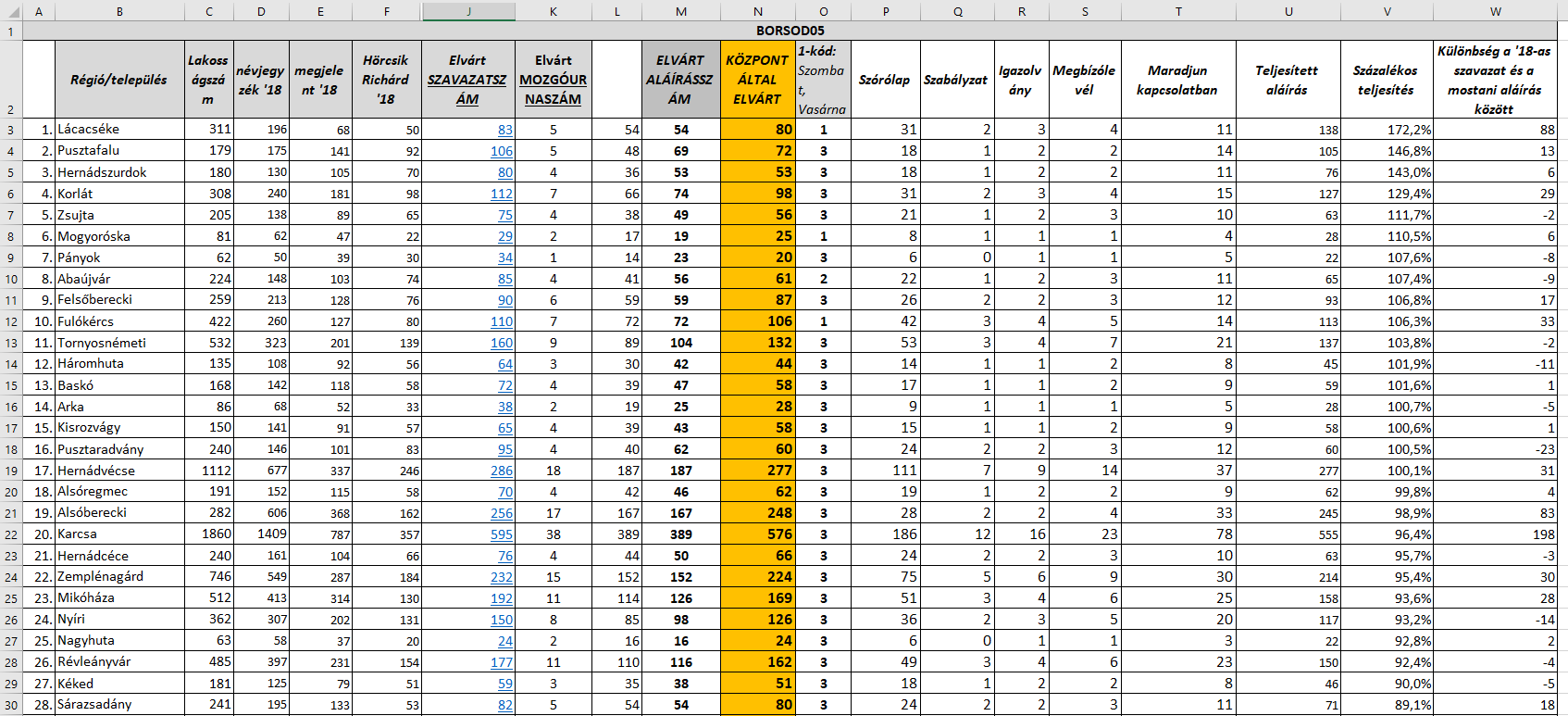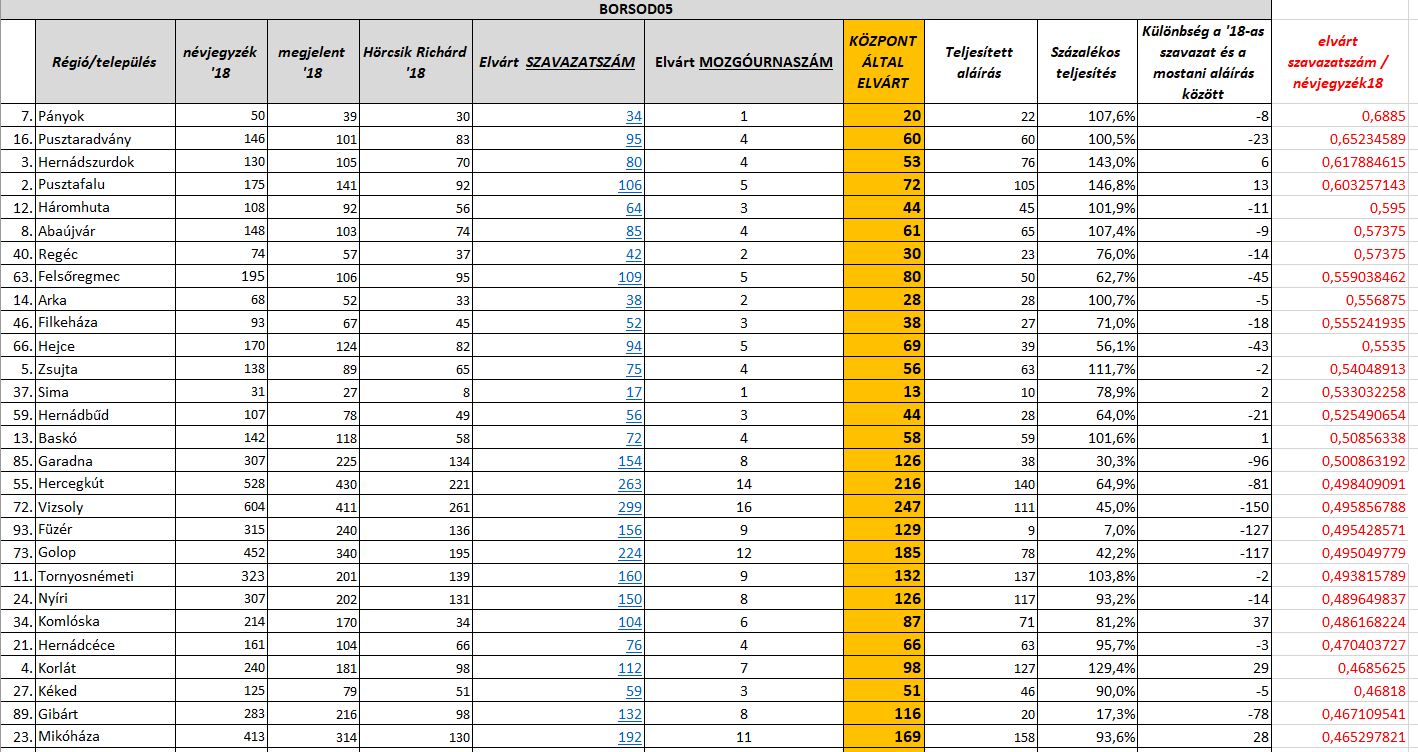The https://english.atlatszo.hu use cookies to track and profile customers such as action tags and pixel tracking on our website to assist our marketing. On our website we use technical, analytical, marketing and preference cookies. These are necessary for our site to work properly and to give us inforamation about how our site is used. See Cookies Policy
Leaked database indicates that Fidesz is preparing a huge mobilisation in Borsod-Abaúj-Zemplén county
According to a database obtained by Átlátszó, Fidesz is preparing statistics covering all settlements in the parliamentary constituency No. 5 of Borsod-Abaúj-Zemplén county on the voters and supporters of Fidesz MP Richárd Hörcsik. The table shows that the party HQ’s expectations for 2022 are higher than the 2018 result. They are now demanding above-average vote totals and are preparing for a huge mobilisation in what is considered a battleground constituency. Gábor Kubatov, party director of the governing party also gave a presentation to local Fidesz activists.
According to an Excel spreadsheet dated 1 March in our possession, local Fidesz mayors, municipal councillors and activists have been given a target number of signatures of support to be collected locally, one municipality at a time. The table gives a percentage of how each municipality is performing, and according to our local source, local Fidesz members “will presumably receive praise and public money, or reprimands, on this basis”.

According to our confidential informant, “they are actually going around the villages, threatening public workers that there will be no public work if they don’t vote for Hörcsik. In fact, local councillors are using their trusted public workers to collect databases during working hours, and to tell less informed people who fear for their jobs who to vote for.” The personal data collected through supporting signatures can also be used for mobilisation on the day of the general election.
According to the information in the file, the Excel spreadsheet was created and saved by Ádám Sáfián, a former colleague of MEP Hörcsik, a Fidesz mayor of Abaújszántó, a small town in the district. Sáfián is apparently no stranger to the NER elsewhere, as he wanted to become president of the weightlifting federation last year.
According to an election expert interviewed by Átlátszó, what is interesting in the table is that the centre’s 2022 expectation is higher than the 2018 actual figure. “If they can deliver that, it will be a brutal result,” said the expert, who asked not to be named.
Download the full table here (xlsx)
Sorting the data in the table shows that the “expected number of votes” for the governing party is extremely high, with more than 50% of the total number of voters on the 2018 electoral register in several small villages in the constituency.
We have sent questions to Ádám Sáfián on this topic, if and when he responds to our request, we will update the story. On 1 March, the mayor of Abaújszántó announced on his Facebook page the launch of the 2022 public works programme, which will involve 143 participants in the small town this year. On 9 February, he also reported that “Dr. Richárd Hörcsik gave a speech in front of more than 300 supporters at a campaign opening event”, in which Gábor Kubatov, vice-president of Fidesz, gave a presentation.
The single-member constituency No. 5 of the county of Borsod-Abaúj-Zemplén, North-Eastern Hungary is a battlefield constituency with no less than nine candidates according to the classification of our Transparent Election 2022 database. The governing parties are running Dr. Richárd Hörcsik again, the candidate of the united opposition is Zsolt Erdei Sándor. The local candidate of the Hungarian Two-Tailed Dog Party, Tamás Vincze, told us that he had heard of municipal workers collecting signatures in support of the governing party, and that the municipalities with the highest number of expected votes on the table were all “poor villages where public work could be the answer”.
In Pusztaradvány, for example, with a population of around 240, official data show that of the 137 residents of working age, 50 are currently in public employment and 25 are registered jobseekers, while the proportion of Roma was 28.2 percent in 2011. Pusztaradvány is one of the ten poorest Hungarian settlements in terms of the personal income tax base per inhabitant, with Fidesz winning 75.2% in the 2018 election and 87.8% in the 2019 election.
Since 2010, public work has been bringing votes to the governing parties
András Hont, editor of Átlátszó, noticed already in 2010 (in an article he wrote for the weekly paper ÉS as a freelancer at the time) that “in many settlements in Northern and Eastern Hungary, in most of the villages, Jobbik won, but in each of them there was a constituency where Fidesz won a victory of astonishing size. Talking to the leaders of Borsodnádasd, Bőcs, Farkaslyuk, Hangony, Hejőbába, Putnok, Sajókaza, the notary or other staff of the office, my suspicion was confirmed: everywhere, the polling station where Fidesz won overwhelmingly was the one with the Roma colony.”
In 2014, within the framework of a joint project of Átlátszó, K-Monitor, Political Capital (PC) and Transparency International Hungary (TI), we tried to map the nature of electoral abuses stemming from vulnerability by using two parallel and mutually supportive methods: statistical analysis of election and public employment data helped us to conduct investigative fieldwork, while local experiences raised new analytical aspects.
Eight years ago, we found that in municipalities where public employment affects a significant proportion of the working-age population, the Fidesz-KDNP national list typically performed much better in April 2014. While the governing parties only achieved outstanding results in 38% of the small settlements (30% stronger than their national average), they also performed outstandingly in two thirds of the small settlements most affected by public employment.
In the village of Forró in Borsod-Abaúj-Zemplén county, the method was caught in the act in the October 2014 local elections: instead of the legendary chain voting or the more modern telephone ballot paper presentation, the voting was simply changed to open voting for several people. Our presence in the municipality made it very difficult to operate the tried and tested system, but it did not prevent it: even on polling day, the incumbent Roma leadership loudly proclaimed that there was no need to be afraid, that open voting was not prohibited by law – and at the polling station, voters showed their completed ballot papers to the appropriate delegate in front of Atlatszo reporters.
Public work for the right vote: open elections in Borsod county
We have discovered an unusual method for checking votes in Sunday’s local election in the settlement of Forró in Borsod County. In place of legenday “chain voting” or a more modern telephone-photographed ballot presentation techniques they simply made the vote open in the case of many people.
Before the 2018 parliamentary elections, we visited some municipalities in Eastern Hungary where, based on our previous experience and the risk analysis of Political Capital experts, there seemed to be a chance that the local representatives of the governing party would try to manipulate the election in some way. However, we found no signs of such preparations, but we did get the impression that the majority of Roma living in the ghettos had become committed voters of the ruling party.
During the 2018 parliamentary elections in another disadvantaged region of Hungary, Baranya County, we found that not only the poorest of the small villages, but also the rural middle class, were grateful to Viktor Orbán for his mass public works. The deliberate fear-mongering and the Erzsébet vouchers handed out as election gifts have turned the inhabitants of small villages towards Fidesz. In the villages in need of public works, the majority, in some cases the overwhelming majority, of the local residents voted for the Fidesz-KDNP party alliance.
Vote tourism may distort the results in the Sárospatak constituency
According to a recent report of Alfahír, 19 people of Ukrainian nationality are registered in Révleányvár, a small village in the same Borsod-Abaúj-Zemplén county constituency, on a house number where there are no houses, only fields. Following a decision by parliament last November, the requirement to live there is no longer a condition for permanent residence, allowing people from outside the local political community to have an uncontrolled say in the election. According to HCLU and Political Capital, the law legalising the establishment of a fictitious address opens the door to electoral tourism even wider than before.
Sándor Zsolt Erdei, a candidate for the Borsod-Abaúj Zemplén County constituency No 5 of the united opposition, told Alfahír that his constituency is extremely large, as it includes 98 settlements, of which only Sárospatak and Sátoraljaújhely are the two larger towns, “but if small villages the size of Révleányvár have a 20-30 percent share of Ukrainians and Slovaks voting, then we cannot talk about a clean election”.
The Excel spreadsheet obtained by Átlátszó predicts a much higher than average Fidesz victory in Révleányvár: 130 out of 397 voters signed up for the governing party, and the party’s expected number of votes is 177 for Fidesz candidate Dr. Richárd Hörcsik.
During the previous elections in 2018, Átlátszó found addresses in several constituencies where dozens of Ukrainian-Hungarian dual citizens were registered, but only on paper. Based on data published by the National Election Office, their role may have been greatest in the constituency of Szabolcs 04, Vásárosnamény, which borders Ukraine – our field experience there also suggested that the participation of fictitiously registered phantom voters, who were only transferred there on election day, meant thousands of extra votes for the Fidesz candidate.
Written and translated by Tamás Bodoky. The Hungarian version of this story is available here. Cover photo: Gábor Kubatov holds a campaign launch for Fidesz activists in the B-A-Z. county single mandate constituency No 5 on 9 February 2022. Photo source: Ádám Sáfián / Facebook.
Hungary. What do you know about Hungary? from atlatszo.hu on Vimeo.



